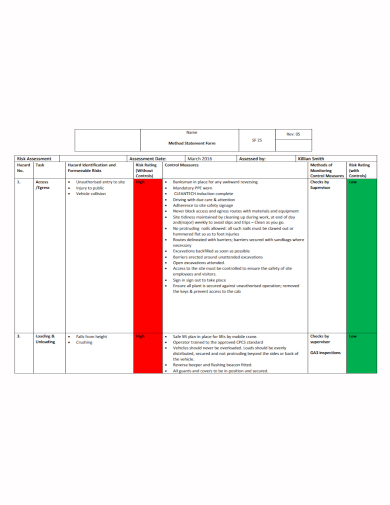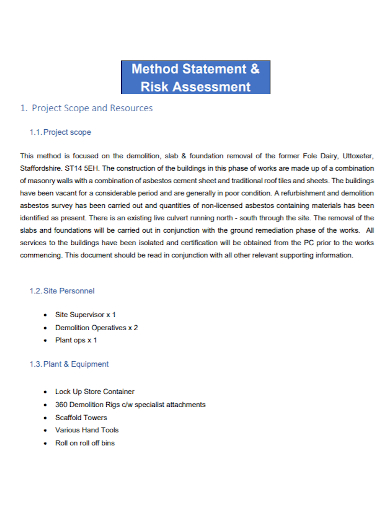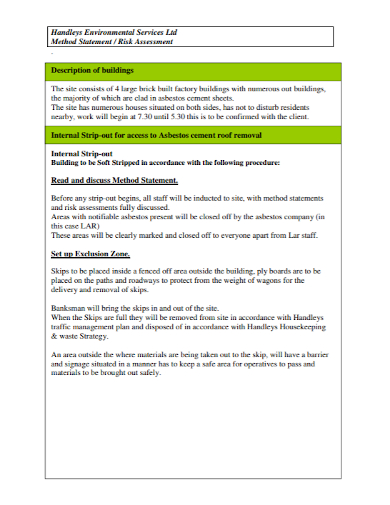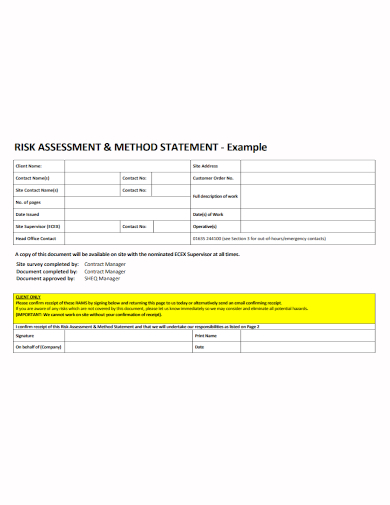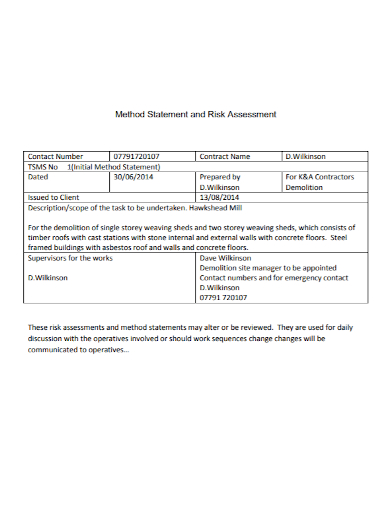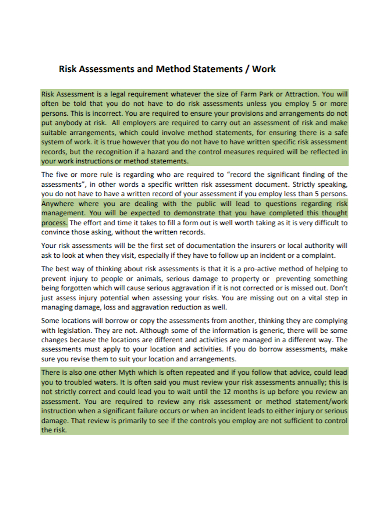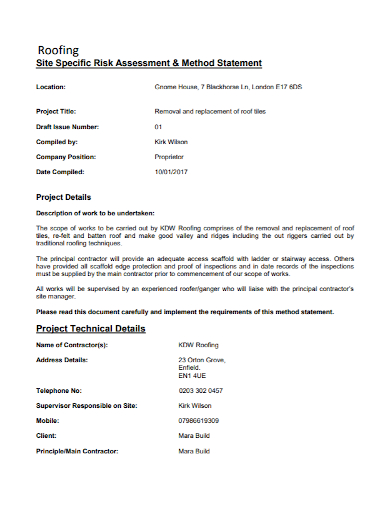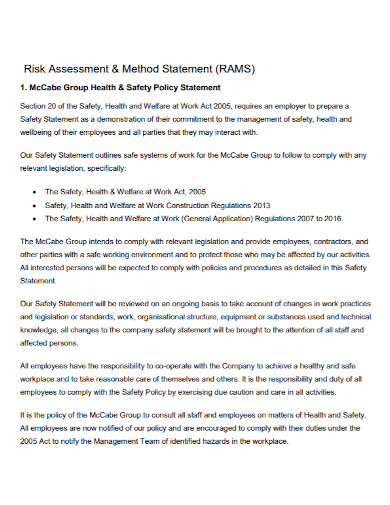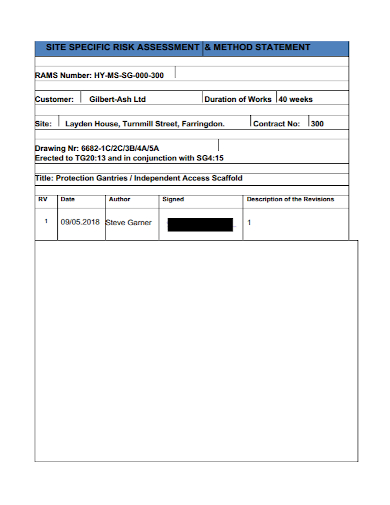Risk assessments are widely used and understood, and companies with more than five employees are required to have one and complete the associated paperwork. Risk Assessment Method Statements (RAMS) are a lesser-known safe system of work…but what exactly are they, how do they differ, and when should you use them? RAMS documents may be encountered while reviewing workplace health and safety and conducting risk assessments. In the construction industry, these documents are frequently at the heart of safe work practices and procedures. These documents may be unfamiliar to you if you’re new to risk management or construction health and safety. So, what exactly are RAMS files? What makes them so vital?
10+ Risk Assessment Method Statement Samples
RAMS stands for Risk Assessment Method Statement, which is a critical health and safety document that identifies the steps that must be taken to safely complete a specific activity or task. RAMS is a risk assessment tool that can be used in connection with the risk assessment process. Risk assessments are used to document workplace hazards, evaluate the severity of risks, and devise effective control measures to eliminate or mitigate those risks. Method statements, also known as a “Safe System of Work,” expand on the information presented in risk assessments by addressing hazard identification, management, and control measures. They describe how to implement control measures and safety precautions, as well as what control equipment to use.
1. Risk Assessment Method Statement
2. Risk Assessment and Method Statement
3. Environmental Risk Assessment Method Statement
4. Sample Risk Assessment Method Statement
5. Client Risk Assessment Method Statement
6. Standard Risk Assessment Method Statement
7. Risk Assessment Work Method Statement
8. Risk Assessment Compliance Method Statement
9. Roofing Risk Assessment Method Statement
10. Risk Assessment Method Policy Statement
11. Site Specific Risk Assessment Method Statement
Key Differences
Risk assessments assist you in identifying potential hazards in the workplace. Once these hazards have been identified, you must analyze them and consider how they may affect health and safety. This allows you to put precautions in place to see if they pose a threat to someone’s safety. This leads to the use of RAMS in a seamless manner.
RAMS (Risk Assessment Method Statements) are more specific. After conducting risk assessments, organizations create documents that contain details about the risks as well as a step-by-step safe system of work/guide that all employees and contractors should follow.
RAMS are also known as method safety statements or safe systems of work documents. Unlike risk assessments, they are less well-known because they are not required by law. So, why would you use them, you might wonder? The main reason is that RAMS improves the health and safety aspects of your operations dramatically, especially if you work in high-hazard industries like oil, gas, chemical, or construction. They safeguard your business from the pitfalls of poor risk management by making your workplace safer for employees and contractors, improving efficiency by laying out specific guidelines for everyone to follow, and protecting your business from the pitfalls of poor risk management.
RAMS are required in high-hazard industries to ensure that employees and contractors alike can perform tasks without risk of injury. It is, in fact, your corporate responsibility to do so. RAMS are common in the construction and oil and gas industries because they are frequently included as a necessity in tender processes.
Most e-permits include RAMS, which ensures that the right people, with the right skills, are working on the right method statement, at the right time, and in the right place. You can ensure that instances that could be avoided are avoided and that your contract workers return home safely in this manner.
FAQs
Which business uses a risk assessment method statement?
Any business can use RAMS to improve the health and safety of its operations. However, businesses in the construction sector are the most likely to use them, as daily tasks in this industry can involve potentially hazardous activities. Contractors can use RAMS to show their safe work practices in many construction projects that rely on tendering goods and services. To ensure effective risk mitigation across your supply chain, check contractors’ health and safety policies and procedures against your organization’s RAMS documents.
What could be one of the benefits of using RAMS documents?
Workers will frequently be obliged to make decisions about how to complete tasks or get around project roadblocks. Decisions must sometimes be made quickly and without formal approval. Method Statements can provide the answers workers require and aid in making safe decisions.
Preparing a RAMS document should not be viewed as a checklist. It is important that everyone is aware of it and that they take the necessary steps outlined in it. Finally, you should automate your systems so that procedures are in place to ensure that RAMS documents are reviewed on a regular basis. They may end up forgotten in a filing cabinet in the corner of the office if you don’t do this. They’re far too important to end up in that situation.
Related Posts
FREE 10+ Scholarship Statement of Purpose Samples in PDF | DOC
FREE 10+ Engineering Problem Statement Samples [ Software, Mechanical, Civil ]
FREE 30+ Information Statement Samples in PDF | MS Word
FREE 50+ Policy Statement Samples in MS Word | Google Docs | PDF
FREE 50+ Summary Statement Samples in PDF | MS Word
FREE 10+ Nursing School Personal Statement in PDF
FREE 9+ Mortgage Statement Samples and Templates in PDF
FREE 10+ Independent Subcontractor Statement Samples in MS Word | Google Docs | Apple Pages | PDF
FREE 10+ Trust Distribution Statement Samples in PDF
FREE 14+ Compliance Statement Samples & Templates in PDF | MS Word
FREE 10+ Extension Impact Statement Samples in PDF | DOC
FREE 10+ Bank Reconciliation Statement Samples and Templates in PDF | MS Word
FREE 10+ Diversity Mission Statement Samples in MS Word | PDF
FREE 10+ Architecture Statement of Purpose Samples [ Sustainable, Graduate, Master ]
FREE 13+ Project Scope Statement Samples in PDF | MS Word

